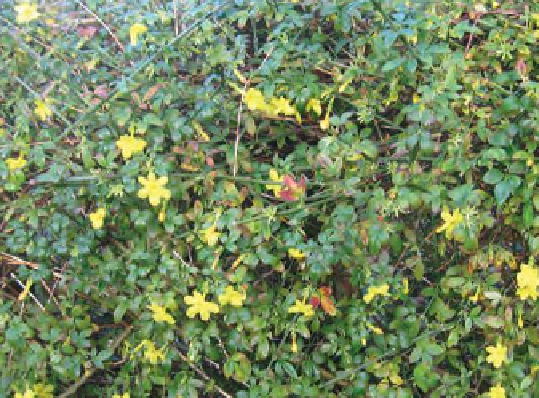Agriculture Reference
In-Depth Information
His third journey, in 1849, was to look for hardy shrubs
and conifers on the west coast of North America. He
collected Santa Lucia Fir (
Abies bracteata
),
Lupinus
cervinus
, the deciduous
Rhododendron occidentale
and
Aesculus californica
in southern California. To the north,
his collection of conifers included large seed quantities
of California redwood (
Sequoia sempervirens
)
.
Other
new species he recorded included Colorado white fir
(
Abies concolor
), Red Fir (
Abies magnifica
), Western
red cedar (
Thuja plicata
), California juniper (
Juniperus
californica
) and two
Ceanothus
natural hybrids (
C. x
lobbianus
and
C. x veitchianus
).
His most memorable experience was in 1853 in the
highland forests 200 km east of San Francisco that
contained Giant redwood (
Sequoiadendron giganteum
- see Figure 2.1). His decision to collect large quantities
of seed and return immediately to England resulted in
huge sales of the saplings of these magnificent trees
for large gardens and estates, the result of which is
still seen in Britain and Ireland today. Lobb returned
to California in 1854, but ill health reduced his plant
collecting activities. He died in San Francisco in 1864.
Robert Fortune
(1812-1880) was born in
Berwickshire. After employment in the Royal Botanic
Garden Edinburgh, he worked in the Horticultural
Society of London's garden. In a first visit to China in
1844, Fortune travelled in the northern areas collecting
a number of species of
Azalea
,
Daphne
,
Wistaria
,
Weigela
and
Arundinaria
. On his return to Britain and
Ireland in 1846, he became Curator of Chelsea Botanic
Garden. In 1848, at the age of 36, he was in China
for two and a half years both as a plant hunter and
surreptitious 'crop stealer'.
His most notable activity involved the transportation
of about 20,000 young tea plants (for the British East
India Company) from the southeastern China region
of Fujian to the Darjeeling area of north India. The
1842 Treaty of Nanjing between China and Britain
allowed Europeans local access only to stipulated
ports. But Fortune disguised himself as a Chinese
man and was able to successfully transport the young
plants, using a number of 'Wardian cases' (a form of
mini-greenhouse). Although only a small proportion
of the tea plants survived the journey, these plants
were partly instrumental in establishing the Indian
tea industry. Several Chinese tea growers were
persuaded to accompany Fortune to India, and their
knowledge was passed on to local growers in India.
Fortune was able to introduce more than 120 plant
species from eastern Asia. These included
Buddleja
lindleyana
,
Camelia '
Robert Fortune',
Camellia '
Captain
Hawes'
, Chionanthus retusus
,
Clerodendrum bungei
,
Corylopsis pauciflora
,
Daphne genkwa
,
Jasminum
Figure 2.19
Jasminum nudifolium
nudiflorum
,
Lonicera standishii
,
Pinus bungeana
,
Rosa fortuniana
,
Rosa '
Fortune's Double Yellow',
Rhododendron fortunei
,
Dicentra spectabilis
,
Forsythia
viridissima
and many chrysanthemum and tree paeony
cultivars.
Fortune returned to China in 1853 and 1858, and
to Japan in 1860. He also visited Indonesia and
Philippines in his travels. He returned to Scotland to
farm in 1862. He died in London in 1880.
Jósef Ritter von Rawicz Warszewicz
(1812-1866)
was born in Wilno, Lithuania (of Polish parents).
After working at a local Wilno botanical garden, he
moved to the Berlin Botanic Gardens. In 1844, he was
recruited for a six-year exploration of Central America
(mainly Guatamala) to look for plants of commercial
potential. The orchids
Cattleya dowiana
and
Cattleya
warscewiczii
were two notable finds. His successful
exploits enabled Germany to acquire a reputation
for newly introduced plant species. A subsequent
exploration in 1851 (mainly to Peru and Bolivia) led to
large numbers of species being found .This included
Canna warscewiczii
(used much subsequently
in breeding lines) and several new species of
Gesneriaceae such as
Sinningia warscewiczii
.
Warszewicz is best known, however, for his collection
of orchids, including
Cycnoches warscewiczii
,
Catasetum warscewiczii
,
Miltonia warscewiczii
,
Paphiopedilum caudatum
,
Sobralia warscewiczii
,
Brassia warscewiczii
,
Epidendrum warscewiczii
,
Mesospinidium warscewiczii
,
Epidendrum
warscewiczii
,
Oncidium warscewiczii
,
Stanhopea
warscewiczii
and the genus
Warszewiczella.
In 1853,
he accepted the position of Director of Cracow
Botanical Gardens until his death in 1866.
Joseph Hooker
(1817-1911) was born in Suffolk
and spent his childhood in Glasgow. He was the son

